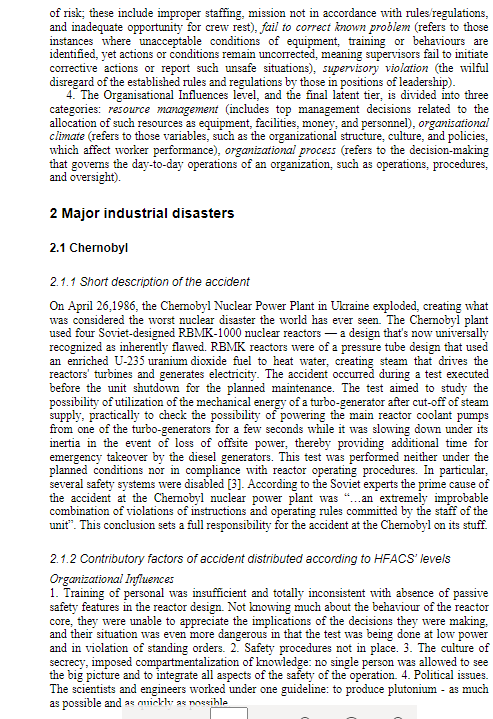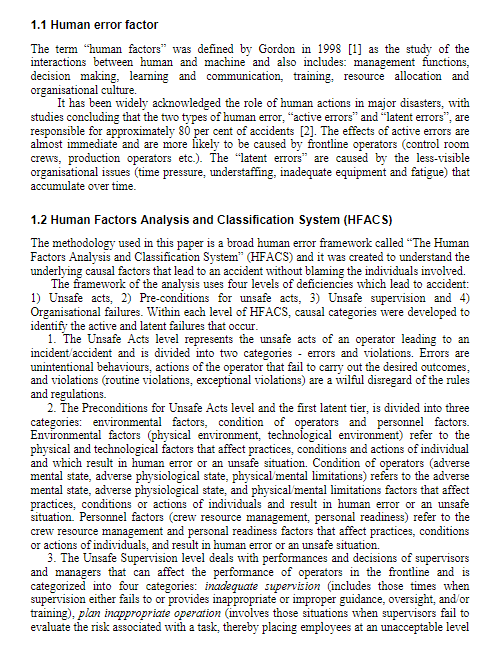



Question 2. [65 points) The short article "Comparison of four major industrial disasters from the perspective of human error factor describes safety issues of some of the major industrial disasters. a List the major safety failures that contributed to "Bhopal disaster b. What are the major outcomes of this study in terms of industrial accidents cases? c State two examples related to human factors that contribute to the disaster. [25 points) [25 points) [15 points] 2.2 Bhopal - 22.1 Short description of the accident Bhopal accident was the spillage of a very toxic substance - methyl isocyanate (MIC) - to the atmosphere in large quantities from a pesticide plant. It led to the dead of more than 5000 people. The methyl isocyanate (MIC) was stored in three underground tanks made of stainless steel that have to be kept refrigerated so that the temperature of content to be close to 0C. To prevent release of methyl isocyanate in the atmosphere, after the tank there was a vent gas scrubber that would neutralize the MIC by spraying alkali. Also, then there was a flare tower to burn the remaining gases going from the vent gas scrubber. The plant was shut down for maintenance two months prior to the accident. Due to a series of errors, lack of knowledge and delays in response of operators and supervisors 40 to 45 tonnes of MIC escaped, part of which got decomposed into hydrogen cyanide. At 2.30 in the moming MIC vapours started affecting people in the vicinity, and a large number of people started running out of the houses. On the morning of 3 December, the local hospital had about 12000 persons. Again on the night of 3/4 December, MIC from the atmosphere recondensed and more people were affected. On the 4 December 1984 Hamidia Hospital had to handle about 55000 people [4]. 222 Contributory factors of accident distributed according to HFACS levels Organizational Influences: 1. Carrying out plant modifications in hazardous facilities without hazard and operability studies; 2. Storing 55 tonnes of MIC while usage daily was 5 tonnes: 3. Neglecting safety management at the unit: 4. No action on earlier accident 4 ATEC Web of Conferences 305, 00017 (2020) https://doi.org/10.1051/matecconf/2020305000 SAM 2019 analysis reports: 5. Heavy reliance on inexperienced operators; 6. decision to reduce operating and maintenance staff in control room plant; Unsafe Supervision 1. using a non-trained superintendent for the plant; 2. failure to recognize that the pressure rise was something abnormal; 3. failure to use the empty MIC tank to release the pressure. Preconditions for Unsafe Acts: 1. Refrigeration plant was not operational: 2. pressure indicator and temperature indicator not working: 3. flare tower was disconnected 4. vent gas scrubber not in active mode: 5. plant modification; 6. use of iron pipelines for MIC: 7. no indicator for monitoring position of valves in control room. Unsafe Acts: 1. Repressurizing the tank when it failed to get pressurized once; 2. failure of shift operator to communicate information on pressure increase to the next operator: 3. issuing orders for washing when methyl isocyanate tank failed to get pressurize: 4. not following the safety precautions while washing MIC lines: 5. failure to recognize the seriousness of the leak; 6. failure to inform Works Manager as soon as the leak started. of risk: these include improper staffing, mission not in accordance with rules regulations, and inadequate opportunity for crew rest), fail to correct known problem (refers to those instances where unacceptable conditions of equipment, training or behaviours are identified, yet actions or conditions remain uncorrected, meaning supervisors fail to initiate corrective actions or report such unsafe situations), supervisory violation (the wilful disregard of the established rules and regulations by those in positions of leadership). 4. The Organisational Influences level, and the final latent tier, is divided into three categories: resource management (includes top management decisions related to the allocation of such resources as equipment, facilities, money, and personnel), organisational climate (refers to those variables, such as the organizational structure, culture, and policies, which affect worker performance), organizational process (refers to the decision-making that govers the day-to-day operations of an organization, such as operations, procedures, and oversight). 2 Major industrial disasters 2.1 Chernobyl 2.1.1 Short description of the accident On April 26,1986, the Chemobyl Nuclear Power Plant in Ukraine exploded, creating what was considered the worst nuclear disaster the world has ever seen. The Chernobyl plant used four Soviet-designed RBMK-1000 nuclear reactors - a design that's now universally recognized as inherently flawed. RBMK reactors were of a pressure tube design that used an enriched U-235 uranium dioxide fuel to heat water, creating steam that drives the reactors' turbines and generates electricity. The accident occurred during a test executed before the unit shutdown for the planned maintenance. The test aimed to study the possibility of utilization of the mechanical energy of a turbo-generator after cut-off of steam supply, practically to check the possibility of powering the main reactor coolant pumps from one of the turbo-generators for a few seconds while it was slowing down under its inertia in the event of loss of offsite power, thereby providing additional time for emergency takeover by the diesel generators. This test was performed neither under the planned conditions nor in compliance with reactor operating procedures. In particular, several safety systems were disabled (3). According to the Soviet experts the prime cause of the accident at the Chemobyl nuclear power plant was "...an extremely improbable combination of violations of instructions and operating rules committed by the staff of the unit". This conclusion sets a full responsibility for the accident at the Chernobyl on its stuff 2.1.2 Contributory factors of accident distributed according to HFACS levels Organizational Influences 1. Training of personal was insufficient and totally inconsistent with absence of passive safety features in the reactor design. Not lonowing much about the behaviour of the reactor core, they were unable to appreciate the implications of the decisions they were making. and their situation was even more dangerous in that the test was being done at low power and in violation of standing orders. 2. Safety procedures not in place. 3. The culture of secrecy, imposed compartmentalization of knowledge: no single person was allowed to see the big picture and to integrate all aspects of the safety of the operation. 4. Political issues. The scientists and engineers worked under one guideline: to produce plutonium - as much as possible and a milk as recible 1.1 Human error factor The term "human factors was defined by Gordon in 1998 [1] as the study of the interactions between human and machine and also includes: management functions, decision making, learning and communication, training, resource allocation and organisational culture. It has been widely acknowledged the role of human actions in major disasters, with studies concluding that the two types of human error, "active errors and latent errors", are responsible for approximately 80 per cent of accidents [2]. The effects of active errors are almost immediate and are more likely to be caused by frontline operators (control room crews, production operators etc.). The "latent errors" are caused by the less-visible organisational issues (time pressure, understaffing, inadequate equipment and fatigue) that accumulate over time. 1.2 Human Factors Analysis and Classification System (HFACS) The methodology used in this paper is a broad human error framework called The Human Factors Analysis and Classification System (HFACS) and it was created to understand the underlying causal factors that lead to an accident without blaming the individuals involved. The framework of the analysis uses four levels of deficiencies which lead to accident: 1) Unsafe acts, 2) Pre-conditions for unsafe acts, 3) Unsafe supervision and 4) Organisational failures. Within each level of HFACS, causal categories were developed to identify the active and latent failures that occur. 1. The Unsafe Acts level represents the unsafe acts of an operator leading to an incident accident and is divided into two categories - errors and violations. Errors are unintentional behaviours, actions of the operator that fail to carry out the desired outcomes, and violations (routine violations, exceptional violations) are a wilful disregard of the rules and regulations. 2. The Preconditions for Unsafe Acts level and the first latent tier, is divided into three categories: environmental factors, condition of operators and personnel factors. Environmental factors (physical environment, technological environment) refer to the physical and technological factors that affect practices, conditions and actions of individual and which result in human error or an unsafe situation. Condition of operators (adverse mental state, adverse physiological state, physical mental limitations) refers to the adverse mental state, adverse physiological state, and physical mental limitations factors that affect practices, conditions or actions of individuals and result in human error or an unsafe situation Personnel factors (crew resource management, personal readiness) refer to the crew resource management and personal readiness factors that affect practices, conditions or actions of individuals, and result in human error or an unsafe situation. 3. The Unsafe Supervision level deals with performances and decisions of supervisors and managers that can affect the perfomance of operators in the frontline and is categorized into four categories: inadequate supervision (includes those times when supervision either fails to or provides inappropriate or improper guidance, oversight, and or training), plan inappropriate operation involves those situations when supervisors fail to evaluate the risk associated with a task, thereby placing employees at an unacceptable level










